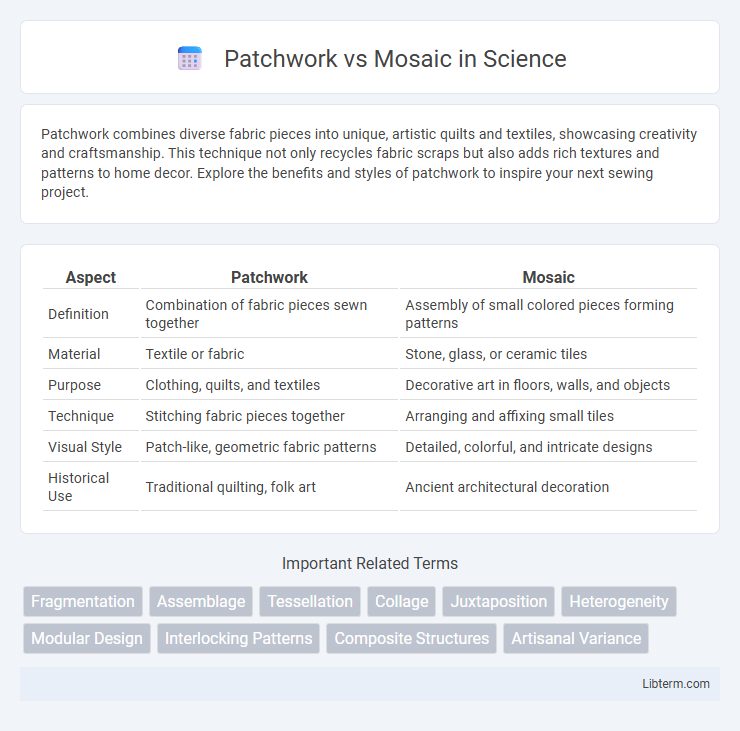Patchwork combines diverse fabric pieces into unique, artistic quilts and textiles, showcasing creativity and craftsmanship. This technique not only recycles fabric scraps but also adds rich textures and patterns to home decor. Explore the benefits and styles of patchwork to inspire your next sewing project.
Table of Comparison
| Aspect | Patchwork | Mosaic |
|---|---|---|
| Definition | Combination of fabric pieces sewn together | Assembly of small colored pieces forming patterns |
| Material | Textile or fabric | Stone, glass, or ceramic tiles |
| Purpose | Clothing, quilts, and textiles | Decorative art in floors, walls, and objects |
| Technique | Stitching fabric pieces together | Arranging and affixing small tiles |
| Visual Style | Patch-like, geometric fabric patterns | Detailed, colorful, and intricate designs |
| Historical Use | Traditional quilting, folk art | Ancient architectural decoration |
Introduction to Patchwork and Mosaic
Patchwork and mosaic are two distinct art forms characterized by assembling smaller pieces to create a larger design, with patchwork typically involving fabric pieces sewn together, while mosaic uses small pieces of glass, stone, or tile. Patchwork has deep roots in textile arts, often associated with quilting and fabric crafts, valued for its tactile and functional qualities. Mosaics are renowned for their durability and ornamental application in architecture and decorative arts, with historical significance dating back to ancient civilizations.
Defining Patchwork: Key Characteristics
Patchwork refers to a design technique that involves sewing together small pieces of fabric with varying colors, patterns, and textures to create a larger, cohesive textile. This method emphasizes irregular shapes and diverse materials arranged in a seemingly random, yet harmonious manner, showcasing a handcrafted aesthetic. Key characteristics include visible seams, a quilted appearance, and a strong emphasis on individuality, often used in quilting and fashion to add visual interest and unique detail.
Understanding Mosaic: Essential Features
Mosaic is characterized by its intricate assembly of small, varied pieces--such as glass, stone, or ceramic--fitted together to create detailed, cohesive images or patterns. Unlike patchwork, which often uses fabric pieces sewn with visible seams, mosaic emphasizes durable, often non-fabric materials arranged meticulously with grout to emphasize texture and color contrast. Key features of mosaic include its structural rigidity, artistic versatility, and historical significance in architectural decoration, offering both aesthetic appeal and functional surface coverage.
Historical Origins and Cultural Contexts
Patchwork originated in ancient Egypt and China as a practical method for repairing textiles, evolving into a folk art form deeply embedded in American quilting traditions during the 18th and 19th centuries. Mosaic dates back to Mesopotamian and ancient Greek civilizations around 3000 BCE, initially used for decorative floors and walls in temples and public buildings, reflecting cultural and religious symbolism. Both crafts illustrate cultural identity and historical narratives, with patchwork emphasizing fabric reuse and storytelling, while mosaics highlight intricate stone or glass arrangements conveying artistic and spiritual themes.
Materials and Techniques Used
Patchwork involves sewing together small pieces of fabric, typically cotton or other quilting fabrics, using techniques like piecing and quilting to create a unified textile design. Mosaic art uses materials such as glass, stone, ceramic, or tile, assembled with adhesives and grout to form images or patterns on surfaces like floors and walls. The patchwork process emphasizes fabric cutting and stitching, while mosaics rely on material arrangement and setting methods for structural durability and visual impact.
Visual and Aesthetic Differences
Patchwork consists of distinct fabric pieces sewn together, often showcasing bold, geometric patterns with clear, defined edges that create a structured and tactile visual effect. Mosaic art features small, uniformly sized tiles arranged to form intricate images or patterns, offering seamless color transitions and a smooth, polished surface that enhances light reflection. The patchwork's textured and segmented appearance contrasts with the mosaic's cohesive and detailed aesthetic, resulting in different visual dynamics and tactile experiences.
Common Applications and Uses
Patchwork is widely used in quilting to create intricate designs by sewing together different fabric pieces, often for blankets, clothing, and home decor. Mosaic art involves assembling small pieces of glass, stone, or tile to form decorative patterns or images, commonly applied in flooring, wall art, and outdoor murals. Both techniques enhance aesthetic appeal in interior design and craft projects by combining multiple elements into cohesive visual compositions.
Pros and Cons: Patchwork vs Mosaic
Patchwork offers ease of installation with versatile fabric options and a cozy aesthetic but often requires considerable sewing skill and time to achieve intricate designs. Mosaic quilting provides a unique geometric appeal and can create striking visual effects quickly but may involve more complex cutting techniques and less fabric flexibility. Choosing between patchwork and mosaic depends on prioritizing either traditional craftsmanship or modern design efficiency.
Modern Trends and Innovations
Patchwork design leverages diverse fabric pieces to create intricate, personalized patterns reflecting cultural heritage while integrating sustainable upcycling practices. Mosaic art, evolving with digital technology, employs advanced software and materials like tempered glass and resin to achieve precision and innovative textures. Both trends emphasize customization and eco-friendly techniques, driving evolution in contemporary textile and art industries.
Choosing Between Patchwork and Mosaic
When choosing between patchwork and mosaic, consider the material and design complexity: patchwork involves sewing fabric pieces into quilted patterns, ideal for textile projects, while mosaic uses small pieces of glass, stone, or ceramic to create intricate visual art. Patchwork offers warmth and texture suited for clothing and bedding, whereas mosaic provides durable surface decoration for walls and floors. Evaluate the intended application, required durability, and artistic style to determine the best technique for your project.
Patchwork Infographic

 libterm.com
libterm.com